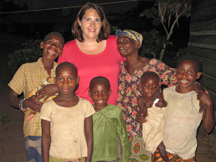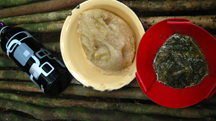Study: Despite protection efforts for elephants, gorillas, local human health declines in the forests of the Central African Republic
May 20, 2014
 |
|
Melissa Remis, a Purdue University professor of anthropology who studies gorillas, human-wildlife interaction and conservation in the Central African Republic, found the BaAka community is facing malnutrition amidst a growing trade in forest products and political and economic volatility in the region. The study was conducted in summer 2012 and her findings are published in the American Journal of Physical Anthropology. (Photo by Carolyn Jost Robinson) |
WEST LAFAYETTE, Ind. — BaAka foragers face growing malnutrition amidst a growing trade in forest products and political and economic volatility in the Central African Republic, despite conservation efforts designed to secure their resource base, according to research from Purdue University.
"This African region is currently struggling with violence and civil unrest, and because the data is from two summers ago, I expect food insecurity and malnutrition to be an even greater problem today," said Melissa Remis, a professor of anthropology who studies gorillas, human-wildlife interaction and conservation in the Central African Republic. "The data collected two years ago is compared to data from 1968, before area logging and conservation began. And there is evidence of a significant health decline, which is exacerbated by policy and societal changes affecting the BaAka's hunting and gathering practices as the region has embraced conservation and industry.
"When focusing on conservation and protecting endangered species we need to remember that those populations live within communities of people who rely on them for material and cultural sustenance."
 |
|
Melissa Remis |
Remis has studied the effects of integrated conservation and development in the Dzanga-Sangha Dense Forest Reserve, and this is a first look at the impact on people's health. The study found 18 percent of women and 6 percent of men are chronically malnourished. The findings are published in the American Journal of Physical Anthropology, and the project was funded by Purdue's Clifford B. Kinley Trust. In June to August 2012, Remis and Carolyn A. Jost Robinson, at the time a Purdue graduate student, measured 141 people's health through physical health measures and dietary surveys to see if and how the wildlife decline and changing economies affected the human population.
They also found 63 percent of women's hemoglobin levels to be low compared to 15.6 percent of women in 1968. These levels, which reveal insufficient iron, can also be influenced by disease or parasitic infection, but they are often used in assessing short-term nutritional status.
"Also of concern was that this data was collected during the region's honey season, which is supposed to be a time of plenty," said Remis, a biological anthropologist who has made 10 trips to the region since 1988. "Instead, these hunters and gatherers were eating one meal a day and only a small percentage consumed meat, even though the population historically relies on meat in their diets."
BaAka eat small antelope, called duikers, other game and fish. Other foods consumed are a bitter manioc root crop, koko leaves, fruits and nuts. BaAka residents from the area villages of Mossapoula and Yandoumbé participated in the study. Mossapoula is closer to park headquarters, off limits to hunters and heavily guarded by ecoguards. The village to the south, Yandoumbé, has easier access to a hunting zone and, residents there consumed more meat. Within a 24-hour sample period, 48 percent of those in Yandoumbé had eaten meat, compared to 21 percent in Mossapoula.
 |
|
Manioc, also known as gozo, (left) and koko leaves are two of the main staples in the BaAka diet. The manioc, a starchy potato like tuber, is grown in the area and the BaAka obtain it by trading meat, honey or koko. However, meat and koko are harder to find in the forests today. It is a wild vine and its leaves are gathered daily by the BaAka women. (Photo by John Jost) |
The Dzanga-Sangha Dense Forest Reserve, known for western lowland gorillas and elephants, was established as a protected area in 1990 by the Central African Republic government and World Wildlife Fund. It includes areas designated for research, tourism, local hunting, safari hunting and logging. The BaAka were directly affected as their hunting and gathering of forest resources was restricted and as some of them found new jobs through the tourism and conservation industries.
"Now that we've been able to document changes in wildlife and the decline of wildlife what are the consequences for the people who are dependent on natural resources and who live around these parks?" Remis said. "It's not just their diet that suffers and changes but their identities and their egalitarian systems are threatened. BaAka men and women do things as partnerships, such as hunting and child care, but we're seeing changes in gender dynamics and power, especially as men pursue new jobs offered in the community."
Remis' previous work has shown declines in wildlife abundance as more immigrants have come into community and there has been overhunting. The immigrants use guns while the BaAka hunt with more traditional methods such as nets and crossbows.
"It was not expected that this park would be a magnet for migration, resulting in an increased population consuming and trading the wildlife," Remis said. "The zoning and area management policies attempt to take into consideration that these traditional hunters and foragers rely on the forest for their livelihoods, but there are always consequences. Despite debate among scientists and news media about refugees associated with land use changes, few studies follow the impact of conservation and economic changes on the indigenous people's health and welfare over time."
Because of the political situation, Remis is not able to return this year to collect data. She will continue analyzing data on individuals' chronic inflammation and also analyzing the nutritional content of fruits and nuts from the region to better understand the BaAka diets and their relationship to human and wildlife health.
Remis expects current events will draw more attention to the human residents of this UNESCO World Heritage Site. The United Nations has announced plans to provide assistance to Central African Republic.
"These BaAka people have been marginalized and poorly integrated into society, so what will happen when this food relief comes in?" Remis said. "How do we move forward in trying to help offer our expertise and understanding to communities as they struggle?"
Remis is affiliated with Purdue's Center for the Environment and Jost Robinson is now an assistant professor of anthropology at University of North Carolina at Wilmington.
Writer: Amy Patterson Neubert, 765-494-9723, apatterson@purdue.edu
Source: Melissa Remis, 765-496-1514, remism@purdue.edu
Related website:
College of Liberal Arts
Note to Journalists: Journalists interested in a copy of the journal article can contact Amy Patterson Neubert, Purdue News Service, at 765-494-9723, apatterson@purdue.edu
ABSTRACT
Examining Short-Term Nutritional Status Among BaAka Foragers in Transitional Economies
Melissa J. Remis and Carolyn A. Jost Robinson
Foragers in transitioning economies are at an increased risk of negative health outcomes as they undergo changes in subsistence patterns and diet. Here, we provide anthropometric data and examine the nutrition and health of adult BaAka foragers in relationship to declining wildlife and economic change in the Dzanga Sangha Protected Areas (APDS), Central African Republic. From June to August 2012, we collected biological data and dietary recall surveys from individuals in Mossapoula (MS) and Yandoumbé (YDBE) villages using standard anthropometric techniques and a single capillary blood finger prick. In our analysis, we identified variation in anthropometric measurements and hemoglobin levels by village (MS = 66, YDBE = 75) and gender (64 men, 77 women). Immigration, increased gun hunting and wildlife trades have reduced forager reliance on forest resources. These changes are evidenced in the marginal health of contemporary BaAka foragers of APDS. Although anthropometric measures of nutritional status do not significantly differ between communities, hemoglobin data highlight inequities in access to forest products between villages with different proximity to community hunting zones. Further, poor dietary diversity and low frequency of purchased foods in the diet indicate that the transition to a market economy has not been fully realized and diets are impoverished. Economic changes appear to have had the most impact at MS village, where forest use is most restricted and consumption of meat and forest products was reduced. This work highlights the nutritional and health needs of foragers in rapidly transitioning economies; especially those impacted by conservation management and zoning policies.

